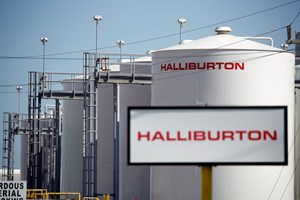Halliburton sees best profit in 12 years as U.S. shale drilling activity slows
(Bloomberg) – Halliburton Co., the world’s biggest provider of fracking work, posted its best earnings for a first quarter in a dozen years despite a shrinking business in the shale patch.
The company that helps oil and gas operators around the globe drill and complete new wells reported quarterly earnings of $679 million, excluding certain items, it said Tuesday in a statement. International sales grew 12% while North America revenue fell 8% compared to a year earlier. Shares fell 1.2% at 9:38 a.m. in New York trading.
“Our customers’ multi-year activity plans across markets and asset types confirms my confidence in the strength and duration of this upcycle,” Chief Executive Officer Jeff Miller said in the statement. “Our international business delivered its 11th consecutive quarter of year-on-year growth.”
The world’s biggest hired hands of the oil field are in the midst of a multi-year pivot away from the once-booming shale patch in search of greater growth overseas.
SLB, a larger competitor which dominates international services work, reported similar results last week with a 13% jump in total revenues while its North American sales dropped 6% from the same period a year earlier. Baker Hughes Inc. will round out oil field-service earnings when it posts results later Tuesday afternoon.
Halliburton, with its unrivaled footprint in all of the major shale basins, offers the closest proxy to U.S. producer activity. After better-than-expected production in 2023, the U.S. shale patch is now in the midst of slowing down amid dwindling inventory for top-tier drilling locations, weaker natural gas prices and industry consolidation. Total North American producer spending is forecast to drop 1% this year, according to Barclays PLC.
The closely watched tally of pre-drilled wells, known as the fracklog, reversed course last month, according to the U.S. Energy Information Administration. The report indicated that the number of wells fracked grew slower than those drilled, offering another indication of a slowing hydraulic fracturing market.



